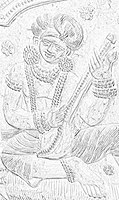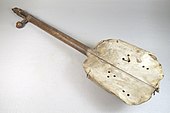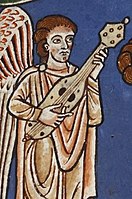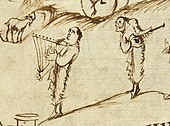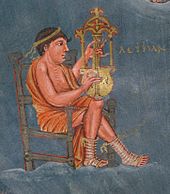
History of lute-family instruments
Lutes are stringed musical instruments that include a body and "a neck which serves both as a handle and as a means of stretching the strings beyond the body".[1]
The lute family includes not only short-necked plucked lutes such as the lute, oud, pipa, guitar, citole, gittern, mandore, rubab, and gambus and long-necked plucked lutes such as banjo, tanbura, bağlama, bouzouki, veena, theorbo, archlute, pandura, sitar, tanbur, setar, but also bowed instruments such as the yaylı tambur, rebab, erhu, and the entire family of viols and violins.[1]
Lutes either rose in ancient Mesopotamia prior to 3100 BC or were brought to the area by ancient Semitic tribes. The lutes were pierced lutes; long-necked lutes with a neck made from a stick that went into a carved or turtle-shell bowl, the top covered with skin, and strings tied to the neck and instrument's bottom.
Curt Sachs, a musical historian, placed the earliest lutes at about 2000 BC in his 1941 book The History of Musical Instruments.[2] This date was based on the archaeological evidence available to him at that time. The discovery of an apparent lute on an Akkadian seal, now in the British Museum, may have pushed the known existence of the plucked lute back to c. 3100 BC.[3]
The lute's existence in art was more plain between 2330–2000 BC (the 2nd Uruk period), when the art had sufficient detail to show the instrument clearly. The instrument spread among the Hittites, Elamites, Assyrians, Mari, Babylonians and Hurrians. By c. 1500 BC the lute had reached Egypt, through conquest, and it had reached Greece by 320 BC both through Egypt and eastern neighbors. The lute spread eastward as well; long lutes today are found everywhere from Europe to Japan and south to India.
The short lute developed in Central Asia or Northern India in areas that had connection to Greece, China, India and the Middle East through trade and conquest. The short wood-topped lute moved east to China (as the pipa) south to India (as the vina), and west to the Middle East, Africa and Europe as the barbat and oud. From these two, and from skin topped lutes known today as rubabs and plucked fiddles, instruments developed in Europe.
Europeans had access to lutes in several ways. Foreign sources came in through Byzantium, Sicily and Andalusia. In the non-literate period, they apparently experimented with locally made instruments which were referenced in documents from the Carolingian Renaissance. This was overwhelmed by incoming instruments and Europeans developed whole families of lutes, both plucked and bowed.
Lute-family instruments penetrated from East and Southeast Asia through Central Asia and the Middle East, through North Africa, Europe and Scandinavia. These days, lute-family instruments are used worldwide.
Although the oldest iconographic evidence concerning lutes deals with long lutes in Mesopotamia and Egypt, some long-necked lutes are shorter than others. Comparatively, the Greek and Byzantine pandura is shorter than the tanbur, even though both are long lutes. Shorter lutes exist among the long-necked lutes today, including the tanburica, cura and komuz.
A short necked lute does not necessarily a small lute, as a guitar or pipa can be a large instrument. Guitars have a sound box as long as the neck. Some members of the rubab family with their long sound-boxes fit into the group of short-necked lutes.
The line of short-necked lutes developed to the east of Mesopotamia, in Central Asia, places like Bactria and Gandhara. There a short, almond-shaped lute surfaced, carried east and west by Sogdiana merchants, become the Chinese pipa and Middle Eastern oud.[63][64][65] Curt Sachs talked about the depictions of Ganharan lutes in art, where they are presented in a mix of "Northwest Indian art" under "a strong Greek influence".[66] The short-necked lutes in these Gandhara artworks were "the venerable ancestor of the Islamic, the Sino-Japanese and the European lute families".[66] He described the Ganhara lutes as having a "pear-shaped body tapering towards the short neck, a frontal stringholder, lateral pegs, and either four or five strings".[66]
While the earliest may be in the Gandhara region, Northern India itself also has ancient short-necked lutes in sculpture, such as one found at Pawāyā, Madhya Pradesh, India, that dates to the Gupta period, 400–499 AD.[67][68] Southern India too has early images of lutes, including 2nd-3rd century AD artwork at the Amaravati Stupa, where a large bodied, short-necked lute is carved into the relief sculpture. Another South India artwork showing a lute is found in the 450-490 AD painting, Padmapani Bodhisattva in the Ajanta Caves.
Much of short lute development happened in the Central Asian area between India, China and Persia. Early short lutes were carved out of a single block of wood (monoxle), not built up in a box or bowl-like modern lutes. An example is the barbat which has been called ancestral to both skin-topped instruments like the gambus as well as to larger wood-topped instruments such as the oud. Names were reused or used across multiple instruments over the millennia; the rabab group is an example of that. The family included short lute-shaped instruments, to larger lutes with multiple chambers (some covered with wood, some with skin), to long-necked lutes that retained the multiple sound chambers and skin over the bowl. Some rababs were plucked, some bowed.
Africa today retains the largest variety of skin-topped pierced lutes, in which the neck is a stick that penetrates the body of the instrument. In some, the neck pokes out the bottom and strings are attached there. Others have the neck end within the instrument's body, edge of the neck's end poking up through the skin, securing the strings. These are not merely instruments brought in from outside and copied across generations, but include instruments that originate from local designs. Ultimately the banjo was one of these.





